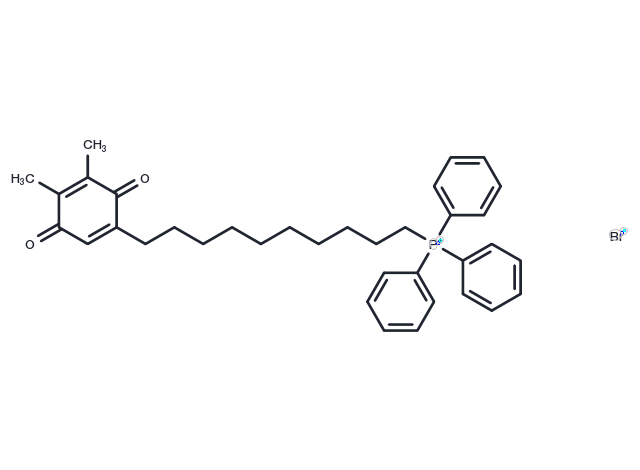Powder: -20°C for 3 years | In solvent: -80°C for 1 year


Visomitin (SKQ1) is a mitochondria-targeted antioxidant that decreases transmembrane potential and production of reactive oxygen species (ROS).

| Pack Size | Availability | Price/USD | Quantity |
|---|---|---|---|
| 5 mg | In stock | $ 43.00 | |
| 10 mg | In stock | $ 68.00 | |
| 25 mg | In stock | $ 126.00 | |
| 50 mg | In stock | $ 207.00 | |
| 100 mg | In stock | $ 365.00 | |
| 1 mL * 10 mM (in DMSO) | In stock | $ 59.00 |




| Description | Visomitin (SKQ1) is a mitochondria-targeted antioxidant that decreases transmembrane potential and production of reactive oxygen species (ROS). |
| In vitro | Direct treatment of tumor infiltrating leukocytes with Visomitin (SkQ1) does not influence their cytotoxicity against Panc02 cells. Visomitin reduces heavily the proliferation of human PDAC cells at 500 nM concentration while not affecting the viability of the cell lines. |
| In vivo | In a study on pancreatic ductal adenocarcinoma (PDAC)-bearing mice, continuous treatment with Visomitin (SkQ1) was found to modify systemic angiogenic factors. Specifically, this treatment led to a decrease in serum KC levels and an increase in VEGF molecules, indicating altered angiogenesis. Additionally, Visomitin treatment resulted in reduced levels of MIP1a and prolactin, alongside elevated amounts of IL-6 and IL-13. The pretreatment setting showed a decrease in TGF-b levels. Contrarily, Visomitin treatment across all protocols reduced the percentage of NKT cells. Although the median survival of PDAC-bearing mice was prolonged with Visomitin treatment, the survival increase did not achieve statistical significance. |
| Cell Research | Panc02 cells are treated 48 h with different concentrations of Visomitin (SkQ1). Cell viability after Visomitin treatment is measured with an EZ4U Kit as described by the manufacturers. Brie?y, 20,000 cells per well are seeded in 96-wellplates and let grow overnight. Afterwards, cells are treated without the medium exchange. A substrate compound from the kit is added and the cells are further incubated for 5 hr at 37°C to convert the yellow colored tetrazolium to its red formazan derivate by living cells. The absorbance is measured at 450 nm |
| Animal Research | Female C57BL/6 mice are used in this study. For experiments on both acute and chronic pancreatitis, mice are divided in three groups. Group A (acute pancreatitis (AP) n=8; chronic pancreatitis (CP) n=12) is treated with 5?nmol/kg Visomitin (SkQ1), group B (AP n=8; CP n=12) is the untreated control, and group C (AP n=8; CP n=7) is the sham group, which is injected intraperitoneally with 0.9% NaCl instead of cerulein and is therefore the negative control group without pancreatitis. For experiments on acute pancreatitis, mice are pretreated with Visomitin for 8 weeks prior to induction of pancreatitis. Mice designated for experiments on chronic pancreatitis receive Visomitin at the same concentration for 8 weeks in parallel with induction of pancreatitis |
| Synonyms | SKQ1 |
| Molecular Weight | 617.61 |
| Formula | C36H42BrO2P |
| CAS No. | 934826-68-3 |
Powder: -20°C for 3 years | In solvent: -80°C for 1 year
DMSO: 55 mg/mL (89.05 mM)
You can also refer to dose conversion for different animals. More
bottom
Please see Inhibitor Handling Instructions for more frequently ask questions. Topics include: how to prepare stock solutions, how to store products, and cautions on cell-based assays & animal experiments, etc.
Visomitin 934826-68-3 Immunology/Inflammation Metabolism NF-Κb Reactive Oxygen Species inhibit Inhibitor SKQ 1 SKQ1 SKQ-1 inhibitor
